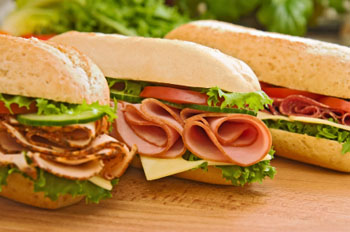Fast food doesn’t have to be a diet killer

Question: If you have to eat fast food, what arethe healthiest options?
Answer: One key premise I promote is that youcan choose to eat healthfully in most restaurants, from fast food to upscale.Especially today, most restaurants, including fast-food chains, offer a cadreof healthier options. Let’s dig in.
‘Fast food’ defined
The term “fast food”conjures up the increasingly dated notion of burgers with a side of fries.Today, a wider-than-ever array of foods are ready fast, including subsand sandwiches, pizza, ethnic fare and more.
Fast-food restaurants “are where customers select foods and paya per-person tab between $3 and $9 before eating. Speed and convenience areking,” according to Mary Chapman, senior director of product innovation atTechnomic, a restaurant industry research firm. Chapman adds that “fastcasual,” now growing faster than traditional fast food places, combines fastservice with higher-quality ingredients and foods that ring up an average tabbetween $10 and $13.
But don’t bestow the halo ofhealth on fast-casual restaurants. Just like nearly all restaurants, theseplaces serve meals across the nutritional spectrum — and it’s up to you to makehealthful decisions.
The risks ofrestaurant meals
Eating restaurantmeals healthfully is downright challenging regardless of the fare. Portions areoften excessive. Large quantities of fats and sugars abound. Sodium canskyrocket. “Research shows that most restaurant meals contain too many caloriesand not enough fruits, vegetables and whole grains,” says Deborah Cohen, aphysician with the Rand research group in Santa Monica, Calif., and lead authorof the report Performance Standards for Restaurants. Eating away from homefrequently is a risk factor for poor health, Cohen adds, which is why peoplewho dine out frequently are more likely to be overweight and at greater riskfor diet-related chronic diseases such as high blood pressure, heart diseaseand Type 2 diabetes.
Healthful fast food?
Hear me out: Keycharacteristics of fast food can combat a few pitfalls of restaurantmeals. No foods are delivered to your table to whet your appetite beforeyour food arrives. There’s nearly no waiting for your food. It’s order and eat.Foods come in a wide range of portion sizes, from small to jumbo.
Over the past coupleof decades, fast-food chains have made moves to satisfy the cry for morehealthful alternatives, such as salads with lower-calorie dressings, grilledchicken sandwiches, baked potatoes, six-inch subs, whole-grain breads andbeverages such as bottled water and low-fat milk. Today, the defaultsides for kids’ meals are more healthful: apple slices, Clementine, babycarrots. That’s true for their beverages as well.
Lastly, fast-foodchains have given us a sneak peek at their nutritionals, healthful ornot, for years. This information is now easily accessible on their Web sitesand in many restaurants.
More nutritioninformation, coming soon
The Affordable CareAct will require most restaurants with 20 or more outlets serving the samemenu to display calories on menus or menu boards by late this year. And otherdata, including fat, sodium and more, must be made available to customers uponrequest.. “Consumers will be able to know the calories of their menu selectionsat over 220,000 restaurants nationwide,” says Joy Dubost, dietitian and seniordirector of nutrition for the National Restaurant Association.
Research to date hasn’tconclusively shown that having a calorie count at hand prompts everyone to makebetter food choices. But experts are optimistic that constant exposure tocalorie totals will eventually impact menu decisions. Recent research by SaraBleich and colleagues at Johns Hopkins Bloomberg School of Public Health showsthat a byproduct of this regulation may be new lower-calorie menu items.
Tips and tactics
Eating betterfast-food meals goes beyond simply choosing more healthful options. Use thesetips and tactics to control portions, calories, fat, saturated fat and sodium:
● Say no to “specialsauces” they’re usually mayonnaise-based, making them fat- and sodium-dense.
● Use lower-caloriespreads and toppings: mustard, ketchup, barbecue sauce, salsa, pico de gallo.
● Skip or go light oncheese, cheese sauce or bacon.
● Pile extravegetables on subs, sandwiches and pizza.
● Order salad dressingon the side, use it sparingly and dilute it with vinegar.
● Pass up tuna, chicken or seafood salad. Mounds of mayonnaisemake them high in fat and calories.
● Order less to eat less.
● Just have to have a favorite guilt food? Splitthe serving with your dining companion and share the guilt.
Article Source: http://www.washingtonpost.com/lifestyle/wellness/fast-food-doesnt-have-to-be-a-diet-killer/2015/03/03/eb42fe6a-bba8-11e4-bdfa-b8e8f594e6ee_story.html
ImageSource: http://www.campingroadtrip.com/Portals/0/emails/newsletter/OutdoorLiving/Edition039/Three-fresh-sub-sandwiches-350x232.jpg
VOCABULARY WORDS:
1. Premise (n.) ~ a proposition on which anargument is based upon or from which a conclusion is drawn
2. Cadre (n.) ~ a tightly knit group
3. Array (n.) ~ an impressively largenumber
4. Bestow (v.) ~ to apply or use
5. Pitfall (n.) ~ a concealed hole thatserves as a trap
6. Whet (v.) ~ to increase or enhance
7. Default (n.) ~ a situation or conditionthat obtains in the absence of active intervention
8. Sneak peek (n.) ~ an opportunity to seesomething before it’s officially available
QUESTIONS FOR DISCUSSION:
1. How often do you eat in fast foodrestaurants? What do you usually eat?
2. Do you agree that fast food can behealthy? Why?
3. Do you think that putting calorie amountand fat content of the meals would discourage people from eating certain menuitems? Why?